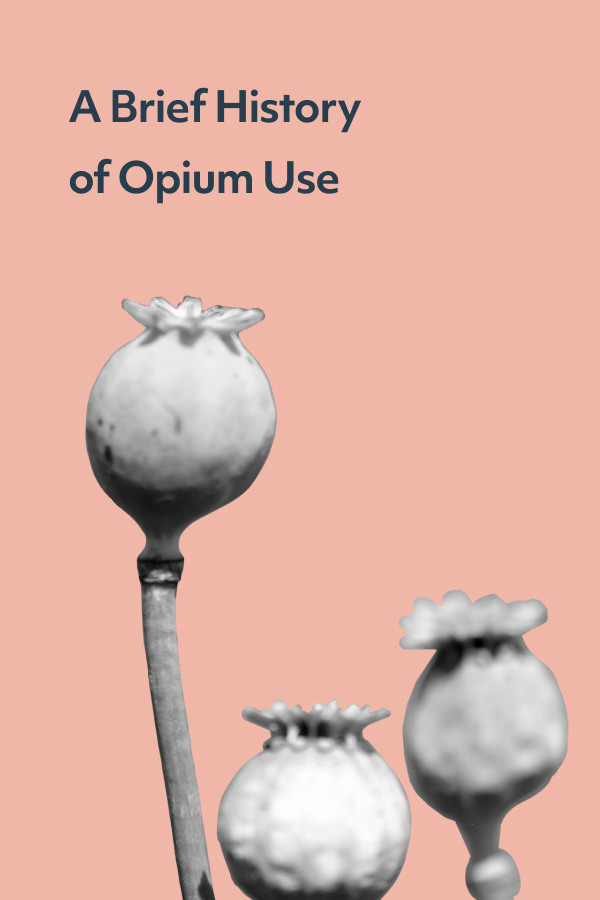Opioids loom large in discussions about substance use, but where did they come from, and why are they such a problem?
We—the nation in general as well as Workit, in particular—talk a lot about the opioid epidemic. But where did it come from? Why is it a larger problem now than in the past?
Opium use has a very long history
Natural opioids are all derived from the opium poppy, which has been cultivated for medical purposes for millennia. Archeological evidence shows that it grew in Mesopotamia, which is sometimes called the Cradle of Civilization, as far back as 5000 B.C., and the Sumerians were using it as an intoxicant around 4000 B.C.
Not all parts of the poppy are narcotic. The flowers are beautiful, and you’ve probably eaten the tiny, black seeds in a muffin once or twice. But if you cut into a round, unripe seed capsule, it will release a white juice that has narcotic effects. When this juice is dried, it is what we call opium.
The opium poppy was introduced to new areas over time. The fossil record shows that it was used in Europe around 2000 B.C. Ancient Greek and Arabic doctors used it for issues as diverse as surgical pain and diarrhea. Laudanum, a tincture of opium, was developed in the 1600s and began to be used as an all-around medical treatment. In the 18th and 19th centuries, recreational use of opium spread (and was sometimes purposely introduced to areas for profit). In 1803, morphine, an alkaloid of opium, was derived for the first time. Later that century, additional alkaloids codeine and papaverine were discovered.
Restricting access
It’s a little hard to imagine dropping into the pharmacy to buy morphine or laudanum without a prescription, like picking up aspirin today. But in the 19th century, that was extremely common. So common, in fact, that opium addiction became widespread at all levels of American society. Doctors began to seek ways to cure people of their opioid dependence, but the drugs were still easily available.
In the 1880s, Congress began to restrict and levy tariffs on opium imports. In 1914, the Harrison Narcotics Act was passed into law, restricting and regulating drugs derived from opium and coca (the plant that cocaine is made from). According to many analyses, this law was motivated by economics and bias against Chinese immigrants rather than by safety concerns. As often happens when legal means of acquiring a substance is restricted, trade in illegal opioids popped up quickly (much as we saw with alcohol during Prohibition). Illicit opioids like heroin started to be sold illegally, and criminal drug charges became punishable with prison sentences.
Pain management and the rise in prescription opioids
Pain management is a huge part of medicine and quality of life, but it didn’t become a recognized field until the 1960s. Researchers began to understand the impact of pain on physical and mental well-being and to seek solutions. In the 1980s, they thought they’d found that solution in relying heavily upon opioids once more. Pharmaceutical companies pushed hard to encourage a narrative of opioids as harmless and effective. Though opioids were legally controlled substances and required prescriptions, they became easy to get … and easy to become dependent upon. Many people went from having a valid need for pain medication after a surgery or injury to having a full-blown addiction. In 2014, the first lawsuits were filed against pharmaceutical companies that knowingly encouraged doctors to prescribe dangerous opioid medications.
As the dangers of opioid medications became more widely recognized, there was a growing pressure on doctors to prescribe fewer of them. If a doctor wouldn’t prescribe a person opioids in the quantities they needed, they often resorted to other methods, like doctor shopping or using illicit street drugs. Recreational use of opioids had never gone away, so they could be bought illegally. The availability of illicit heroin surged after 2010.
The opioid crisis
Opioid addiction and overdose have reached a point that we commonly refer to it as an “opioid crisis” or “opioid epidemic.” In 2017, the US Department of Health and Human Services declared a public health emergency around the opioid crisis. The CDC recognizes three waves of opioid overdose deaths:
- First wave—Prescription medications: In the 1990s, there was a great increase in clinicians prescribing opioids, and overdose deaths involving prescription opioids began rising from 1999.
- Second wave—Heroin: Beginning in 2010, there was a surge in the availability of heroin and a correlating rapid increase in heroin-related overdose deaths.
- Third wave—Synthetic opioids: Since 2013, overdose deaths involving synthetic opioids have been sharply increasing. These are largely due to the advent of fentanyl availability and presence in other drugs.
According to the CDC, provisional data show an estimated 107,622 drug overdose deaths in the United States during 2021, a heartbreaking record high. In 2019, an estimated 10.1 million people misused opioids (of those, 9.7 million people misused prescription pain meds and 745,000 people used heroin). An estimated 2 million Americans meet the diagnostic criteria for opioid use disorder.
The effects of untreated substance misuse are wide-ranging and potentially fatal, including:
- Increased tolerance, cravings, and dependence resulting in severe withdrawal symptoms
- Health problems such as difficulty sleeping, heart failure, and increased risk of injury
- Deficits in working memory
- The onset of psychiatric disorders such as depression and anxiety
- Miscarriage, stillbirth, and birth defects, including neonatal abstinence syndrome
- Spread of infectious diseases like HIV and hepatitis through needle-sharing
- Chronic unemployment and financial or legal problems
Treatment gaps and accessibility
There are three medications approved by the FDA to treat opioid use disorder, methadone, buprenorphine, and naltrexone. In a medication-assisted treatment (MAT) program, one of these medications is administered under the guidance of a clinician, with behavioral health support like counseling. MAT has shown far greater success in treating opioid use disorder than talk-based programs alone, and is promoted by the Substance Abuse and Mental Health Administration, National Institute on Drug Abuse, World Health Organization, and others.
Despite opioid use disorder being an epidemic-level public health concern and the acknowledgment that MAT is vital, there are large treatment gaps. Care is often least available in areas where the need is the greatest, and many traditional models of addiction care are neither accessible nor effective. These widening treatment gaps affect patients of all backgrounds and lived experiences. We’ve written before about the racial disparities in treatment availability, and it continues to be a concern.
For all of these challenges, there is more hope and help for people with opioid use disorder than ever before. Since the COVID-19 pandemic began, restrictions around prescribing buprenorphine via telehealth eased, making it possible for more people to access care. Organizations exist in many states and regions to provide the opioid overdose reversal drug naloxone (Narcan) for free or at low prices. And many states have earmarked funds they receive from settlements with pharmaceutical companies to go toward opioid education and treatment programs.
If you or someone you know is misusing prescription pain meds, taking recreational opioids, or taking other drugs, which are often adulterated with fentanyl, learn more about the treatment options and support available for opioid use disorder.









